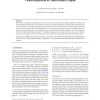Free Online Productivity Tools
i2Speak
i2Symbol
i2OCR
iTex2Img
iWeb2Print
iWeb2Shot
i2Type
iPdf2Split
iPdf2Merge
i2Bopomofo
i2Arabic
i2Style
i2Image
i2PDF
iLatex2Rtf
Sci2ools
CGF
2008
2008
Visual Inspection of Multivariate Graphs
Most graph visualization techniques focus on the structure of graphs and do not offer support for dealing with node attributes and edge labels. To enable users to detect relations and patterns in terms of data associated with nodes and edges, we present a technique where this data plays a more central role. Nodes and edges are clustered based on associated data. Via direct manipulation users can interactively inspect and query the graph. Questions that can be answered include, "which edge types are activated by specific node attributes?" and, "how and from where can I reach specific types of nodes?" To validate our approach we contrast it with current practice. We also provide several examples where our method was used to study transition graphs that model real-world systems. Categories and Subject Descriptors (according to ACM CCS): H.5.2 [Information Interfaces and Presentation]: User Interfaces; I.3.8 [Computer Graphics]: Applications; I.6.4 [Simulation and Mode...
| Added | 09 Dec 2010 |
| Updated | 09 Dec 2010 |
| Type | Journal |
| Year | 2008 |
| Where | CGF |
| Authors | A. Johannes Pretorius, Jarke J. van Wijk |
Comments (0)

